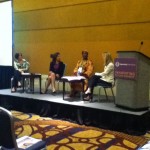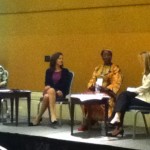Breakout Session: Why Women? Why Now?
In families where women have an income, they have a voice in financial decisions, resulting in better nutrition, health and education for children–including girls. In this breakout session, we learned more about why and how Opportunity International invests the majority of its dollars in serving the most vulnerable people on the planet–women. Panelists shared stories of hope and transformation from their daily work at Opportunity, or their Insight Trip and travel experiences to meet our women clients.

Facilitator: Ruth-Anne Renaud, VP, women’s philanthropy
Panelists:
Diane Griffin, VP, program management
Deborah Farrington, Founder and general partner, StarVest Partners, L.P.; Member, Opportunity International Board of Directors
Nadine Pembele, Training director, Opportunity DRC
Introductions by the Panelists
Nadine: I grew up and I saw my mother struggle. It’s so important to help women, because women in Africa struggle, and I saw it in my family.
Deborah: I am a venture capitalist and big idea person, and this idea of microfinance to empower women was a big idea. That’s why I became a involved with Opportunity.
Diane: At Opportunity, I am in the international business development department. We are the promise-keepers, we manage corporate grants and ensure that the promises we make to those corporate donors are kept. Evaluation is key to that field, so we’re working to do that analysis and demonstrate the impact in particular on women.
The Reality for Women
- Women do 66% of the world’s work and receive only 10% of the pay.
- Seventy percent of the three billion people who live on less than $2 a day are women.
The Potential
- When a girl receives seven or more years of education, she will marry four years later and 2.2 fewer children.
- Women invest 90% of their earnings in their family, while men typically only invest 35%.
- Education and microfinance are the keys to breaking this cycle of poverty.
The Solution – Banking on Women
- Access to financial services
- Reach and focus to access more women clients
- Education of girls
Nadine:
Like the name of this panel, it’s not about tomorrow. It’s about now. Sixty-five percent of our clients are women. That’s why we need to help women now. I am passionate about Opportunity–about our methods and the services we offer. In the beginning, the clients were not sure about what we were telling them, but now they see that these services work. They’re telling us that they are the difference. We received more clients through word of mouth. The women we work with don’t have much, but they have spirit–they will travel long distances and work hard to get what they need, and they will not give up. You must travel to come see that in person.
Debby:
The business model is important. When you get down to it, it’s the human story. I went to see the work in Nicaragua in 2007, and Uganda with my nephew in 2010. It was so transformational for him, he went back the following year. We went to a Trust Group meeting, led by a Ugandan staff member named Teddy. Teddy took us to Trust Group meetings where we met women clients like Clemencia and Jennifer. Clemencia’s husband had been killed in a bus accident. Jennifer had just been burgled when we went to visit, but Teddy assured her Opportunity would help her with financial tools to rebuild. Finally, we went to Bright Angels School, where all the children shouted out a welcome to us, and the proprietor was going to take out a loan in order to improve the school, move to a better building and more. I encourage those of you who can to go on an Insight Trip to see it for yourself.
Ruth-Anne: I’m hearing things in these stories about how we meet clients’ needs despite their struggles. How do we accomplish this?
Diane:
This is the biggest way that products and services come to life–by listening to clients and helping them access tools that get them through the day. We determine what their needs with extensive research. Our banks had been meeting these needs, but we needed to be able to determine even more what clients needed to survive. The numbers can tell us a lot but we also need to have the conversations with clients, that’s why we began offering tools like school fee loans, some of which can be paid on a cashless basis, because that was what clients were requesting.
Ruth-Anne: If you want to learn more and get involved there are many ways to start. You can start an online fundraiser, or read Half the Sky: Turning Oppression into Opportunity for Women Worldwide. Thank you for believing that empowering women cannot wait until tomorrow.